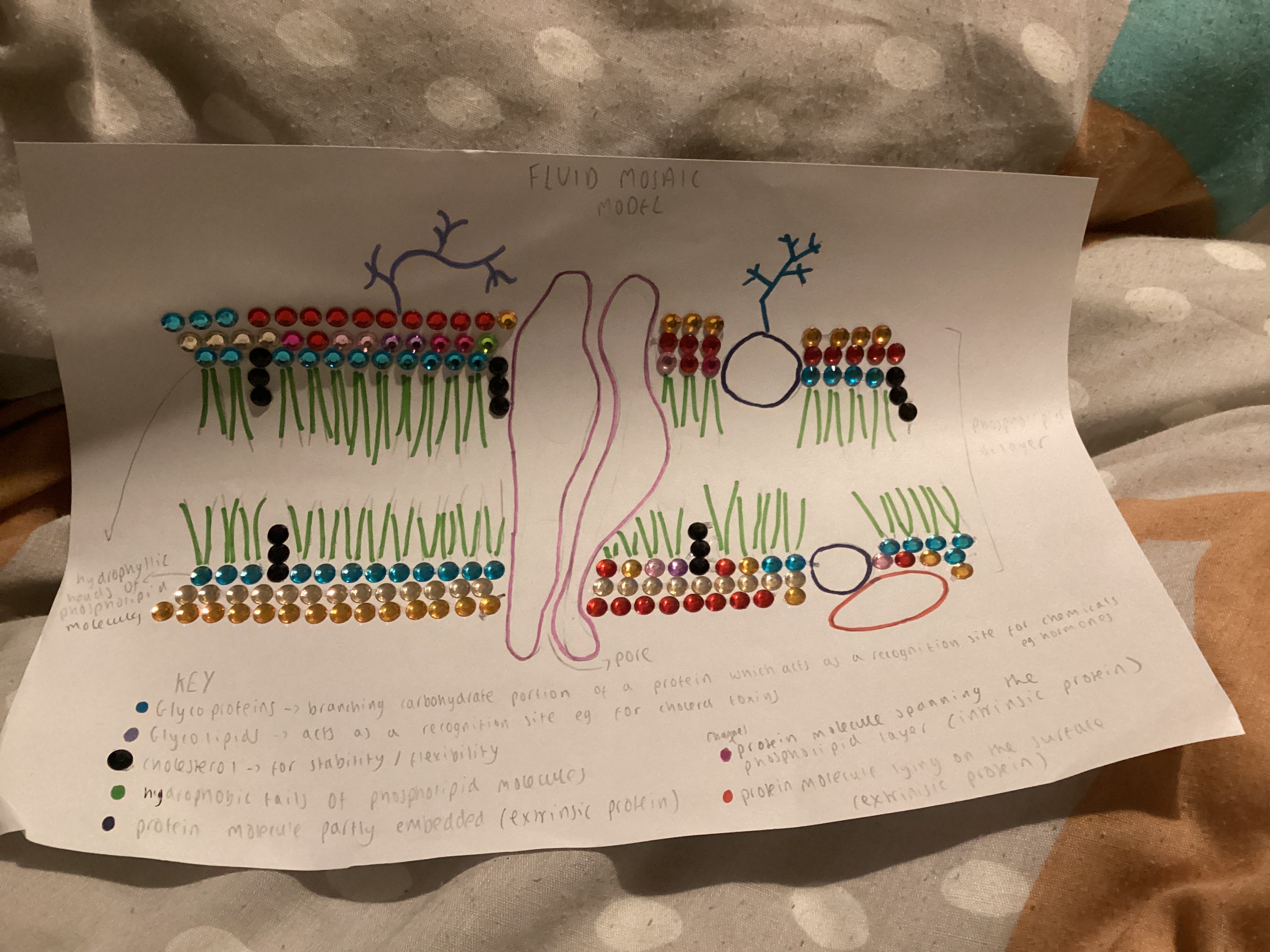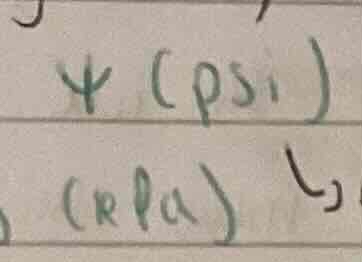Biological membranes
1/82
There's no tags or description
Looks like no tags are added yet.
Name | Mastery | Learn | Test | Matching | Spaced |
|---|
No study sessions yet.
83 Terms
What do membranes cover
The surface of every cell
Functions of membranes
Partially permeable barrier between cell and environment allowing selected molecules in and out, PPM between organelles and cytoplasm allows processes to occur separately, site for biochemical reactions, site of all cell communication
Phospholipids
Type of lipid made from 2 fatty acid chain tails and a phosphate group head
What adjectives describe the head
Polar and hydrophilic
Polar
Molecules have an uneven distribution of charge
Hydrophilic
Water loving
Adjectives to describe fatty acid tails
Non polar, hydrophobic
Hydrophobic
Water hating
Why are phospholipids shape/structure what they are
Due to their polar nature and the way they interact with water
What structures do phospholipids form
Micelles, phospholipid bilayer
Micelles
Phospholipids arranged in a circle with tails pointing into the centre and heads pointing out
Bilayer
2 layers of phospholipids, tails on inside heads on outside
What kind of molecule is cholesterol
Lipid
Role of cholesterol
Controls membrane fluidity
What does more cholesterol mean
Less fluid membrane to less permeable
What makes up 45% of mass of membrane
Proteins
Type of proteins
Intrinsic and extrinsic
Intrinsic proteins
Span the width of the membrane
Functions of intrinsic proteins
Channel proteins- are carrier molecules, transport substances such as ions sugars and amino acids that can’t diffuse across the membrane
Function of extrinsic proteins
Receptors- on cytosolic side of protein(pointing out to cell) are involved in cell signalling
Glycoproteins
Are a branching carbohydrate portion of a protein that acts as a recognition size for chemicals,,hormones, enzymes or used in cell adhesion
Glycolipids
Are lipids with attached carbohydrate chain, act as a recognition site for the immune system
Cell signalling
Cells can signal each other via direct contact or messengers
Examples of messengers
Neurotransmitters, hormones
Small non polar messengers
What kind of messengers can pass through the membrane
What do messengers do that can’t pass through the membrane
Must bind to membrane bound receptors such as glycoproteins
Antagonists
Drugs that bind to normals messengers
Example of antagonists
Antiemetics- anti sickness drug
Agonists
Drugs that bind to receptors and mimic the body’s normal messengers
What is the model of cell membrane structure called
Fluid mosaic model

Absolute uncertainty
Scale on measuring device
Percentage error
Uncertainty/ volume measured x 100
Diffusion
The net movement of particles down a concentration gradient
What type of transport is diffusion
Passive
Passive transport
Only requires kinetic energy not metabolic energy (ATP)
Equilibrium
No net movement of molecules in one direction
Factors affecting the rate of diffusion
Temperature, concentration difference, surface area, thickness of membrane, size of molecules
How does temperature affect the rate of diffusion
Higher temp= higher RoD as particles have more kinetic energy and move at higher speeds
How does concentration difference affect the rate of diffusion
Large conc difference= higher RoD as overall movement will be larger
How does surface area affect the rate of diffusion
The larger the surface area of an exchange surface= higher RoD
How does thickness of membrane affect the rate of diffusion
Thinner the exchange surface = faster `RoD
How does size of molecule affect the rate of diffusion
Smaller= faster rate
Simple diffusion
Diffusion in the absence of a barrier or membrane
What do particles pass through during diffusion
Phospholipid bilayer
What needs to be true to allow for diffusion
Membrane must be permeable to particles which need to be small and non polar
Why can’t polar molecules pass through the phospholipid bilayer
The hydrophobic interior repels the positive or negative charge so ions and other polar molecules can’t pass through
Why can water pass through at a slow rate
It has slight charges so moves through but slowly
Why are membranes described as partially permeable
Some polar molecules pass through, some don’t some polar molecules pass trough easier than larger ones
How do polar and large molecules diffuse
Through the channel(intrinsic) protein
How do polar and large molecules diffuse
Through the channel(intrinsic) protein
Active transport
Movement of molecules against concentration gradient
What do cells use in active transport
Carrier proteins to pump molecules and ions across the membrane, energy
What is the energy used in active transport in the form of
ATP
ATP
Adenosine triphosphate
What produces atp
Mitochondria though respiration
When doe cells use active transport
They need more of a substance inside than outside the cell, they need a substance Whicker than simple diffusion can get it
What do cells that undertake a lot of active transport need
Lots of mitochondria
Examples of active transport
Glucose absorption from intestines, magnesium from soil, calcium in muscle cells, bulk transport (exocytosis releasing large quantities of protein from a cell)
Similarities between AT + facilitated diffusion
Through carrier proteins, both transport substances across a membrane
Differences between AT+ facilitated diffusion
AT: needs ATP, against concentration gradient, only one way
FD: doesn’t need energy, down concentration gradient, goes both ways
What does concentration refer to
The mass of solute present
Water potential
The tendency of water molecules in a system to move
What is water potential measured in
Kilopascals (kPa)
What is the symbol for water potential
Psi

What has the highest water potential
Pure water
What have lower wp than pure water
Solutions- have negative water potentials
Water potential of pure water
0 kPa
What has the higher water potential -100kPa or -40pkPa
-100
Where do water molecules move between
From a region of high water potential to a region of low/ more negative WP
Osmosis
The net movement of water molecules from an area of high water potential to a region of low water potential down a water potential gradient across a plasma membrane
Why does water move in and out of cells
The cytoplasm of a cell is a fairly concentrated solution of salts and sugars so water will either move into or out of the cell depending on the concentration of the solution in it
Why can’t plants control water potential
Due to the fluid around them
What happens to cellulose cell walls in plants when water enters via osmosis
Hydrostatic pressure increases and pushes the membrane shading the rigid cell walls
What is the pressure extend on the cell walls called
Turbot pressure
What happens when a plant cell is in a solution with a lower water potential than their own
Water is lost from the cells resulting in a reduction in volume of the cytoplasm
What does a reduction in volume of the cytoplasm lead to
The cell surface membrane is pulled away from the cell way- cell is plasmolysed
What happens when an animal cell is placed in a solution with a higher water potential that that of the cytoplasm
Water will move into the cell via osmosis and the hydrostatic pressure inside the cell will increase
Width of cell surface membrane
7nm
Why is it bad for the cell to intake more water
The cell surface membrane can’t withstand the increased pressure as it is very thin and theres
What is it called when a cell breaks/ bursts
Cytolysis
What happens when an animal cell is placed in a solution with a lower water potential than that of the cytoplasm
It will lose water causing a reduction in its volume resulting in the cell surface membrane to pucker
What is it called when the csm puckers
Crenation
What prevent cytolysis and crenation
There are control mechanisms in place that make sure that cells are surround by equal water potentials so water is not lost or absorbed by the cell